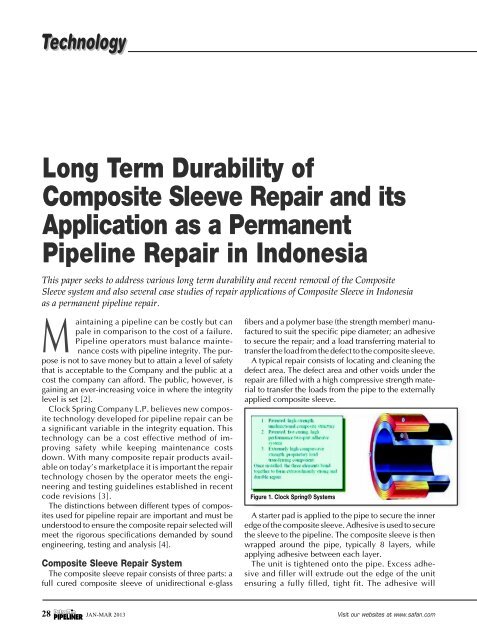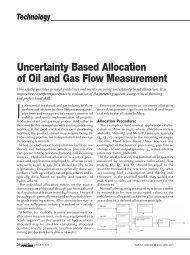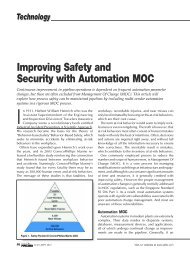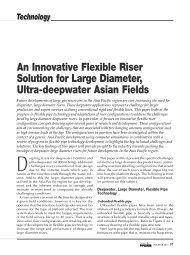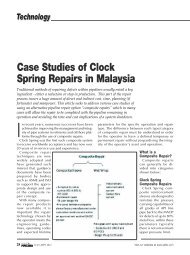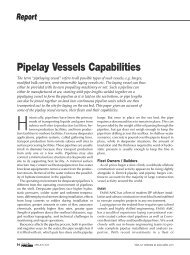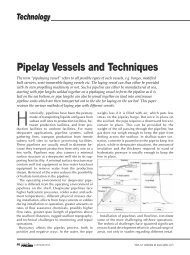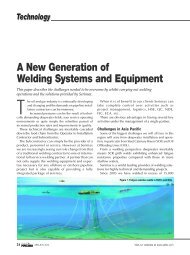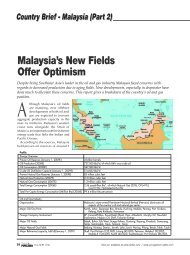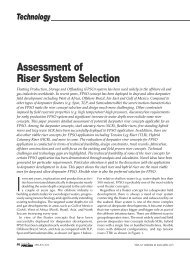Long Term Durability of Composite Sleeve Repair and its ...
Long Term Durability of Composite Sleeve Repair and its ...
Long Term Durability of Composite Sleeve Repair and its ...
You also want an ePaper? Increase the reach of your titles
YUMPU automatically turns print PDFs into web optimized ePapers that Google loves.
Technology<br />
<strong>Long</strong> <strong>Term</strong> <strong>Durability</strong> <strong>of</strong><br />
<strong>Composite</strong> <strong>Sleeve</strong> <strong>Repair</strong> <strong>and</strong> <strong>its</strong><br />
Application as a Permanent<br />
Pipeline <strong>Repair</strong> in Indonesia<br />
This paper seeks to address various long term durability <strong>and</strong> recent removal <strong>of</strong> the <strong>Composite</strong><br />
<strong>Sleeve</strong> system <strong>and</strong> also several case studies <strong>of</strong> repair applications <strong>of</strong> <strong>Composite</strong> <strong>Sleeve</strong> in Indonesia<br />
as a permanent pipeline repair.<br />
M<br />
aintaining<br />
a pipeline can be costly but can<br />
pale in comparison to the cost <strong>of</strong> a failure.<br />
Pipeline operators must balance maintenance<br />
costs with pipeline integrity. The purpose<br />
is not to save money but to attain a level <strong>of</strong> safety<br />
that is acceptable to the Company <strong>and</strong> the public at a<br />
cost the company can afford. The public, however, is<br />
gaining an ever-increasing voice in where the integrity<br />
level is set [2].<br />
Clock Spring Company L.P. believes new composite<br />
technology developed for pipeline repair can be<br />
a significant variable in the integrity equation. This<br />
technology can be a cost effective method <strong>of</strong> improving<br />
safety while keeping maintenance costs<br />
down. With many composite repair products available<br />
on today’s marketplace it is important the repair<br />
technology chosen by the operator meets the engineering<br />
<strong>and</strong> testing guidelines established in recent<br />
code revisions [3].<br />
The distinctions between different types <strong>of</strong> composites<br />
used for pipeline repair are important <strong>and</strong> must be<br />
understood to ensure the composite repair selected will<br />
meet the rigorous specifications dem<strong>and</strong>ed by sound<br />
engineering, testing <strong>and</strong> analysis [4].<br />
<strong>Composite</strong> <strong>Sleeve</strong> <strong>Repair</strong> System<br />
The composite sleeve repair consists <strong>of</strong> three parts: a<br />
full cured composite sleeve <strong>of</strong> unidirectional e-glass<br />
fibers <strong>and</strong> a polymer base (the strength member) manufactured<br />
to suit the specific pipe diameter; an adhesive<br />
to secure the repair; <strong>and</strong> a load transferring material to<br />
transfer the load from the defect to the composite sleeve.<br />
A typical repair consists <strong>of</strong> locating <strong>and</strong> cleaning the<br />
defect area. The defect area <strong>and</strong> other voids under the<br />
repair are filled with a high compressive strength material<br />
to transfer the loads from the pipe to the externally<br />
applied composite sleeve.<br />
Figure 1. Clock Spring® Systems<br />
A starter pad is applied to the pipe to secure the inner<br />
edge <strong>of</strong> the composite sleeve. Adhesive is used to secure<br />
the sleeve to the pipeline. The composite sleeve is then<br />
wrapped around the pipe, typically 8 layers, while<br />
applying adhesive between each layer.<br />
The unit is tightened onto the pipe. Excess adhesive<br />
<strong>and</strong> filler will extrude out the edge <strong>of</strong> the unit<br />
ensuring a fully filled, tight fit. The adhesive will<br />
28 JAN-MAR 2013 Visit our websites at www.safan.com
cure in about two hours <strong>and</strong> the repair area can be<br />
re-coated <strong>and</strong> backfilled. The entire installation takes<br />
only about 30 minutes.<br />
Case Study <strong>of</strong> Recent Removal <strong>and</strong> <strong>Long</strong><br />
<strong>Term</strong> <strong>Durability</strong> Examination<br />
Case Study No. 1: Five (5) Years <strong>of</strong> Services<br />
North American Natural Gas Pipeline: 30 inch diameter.<br />
<strong>Repair</strong> at a girth weld. Moist <strong>and</strong> warm environment.<br />
Pipeline subjected to alternating wet <strong>and</strong> dry<br />
conditions.<br />
Year <strong>of</strong> Installation: 2005<br />
Year <strong>of</strong> Removal: 2010<br />
A subsequent ILI inspection indicated the potential for<br />
metal loss beyond that which existed prior to the repair<br />
installation. The concern was raised corrosion under the<br />
repair was active. The operator investigated. The repair<br />
was removed in 2010 as part <strong>of</strong> a continuous improvement<br />
program. Photographs from the removal are shown<br />
in Figure 2.<br />
The unit was selected to be removed to better enable the<br />
passage <strong>of</strong> future pigs. Photographs <strong>of</strong> the removal are<br />
shown in Figures 3 <strong>and</strong> 4.<br />
Conclusions: The dent was well restrained. No evidence<br />
<strong>of</strong> any integrity threat. The composite sleeve had<br />
to be removed with significant force required to<br />
dislodge the coil. The repair was 100% effective. No<br />
degradation was observed.<br />
Conclusions: After 5 years <strong>of</strong> service, un<strong>its</strong> were well<br />
installed <strong>and</strong> were very difficult to remove. All un<strong>its</strong><br />
were well bonded to the carrier pipe <strong>and</strong> each layer<br />
within the repair coil was well bonded. No new corrosion<br />
under the repair was identified.<br />
Case Study No. 2: Five (5) Years <strong>of</strong> Services<br />
Asian Oil pipeline. A repair <strong>of</strong> a rather significant dent.<br />
Year <strong>of</strong> Installation: 2006<br />
Year <strong>of</strong> Removal: 2011<br />
The climate is very tropical, hot <strong>and</strong> humid with<br />
significant moisture present in various parts <strong>of</strong> the year.<br />
Case Study No. 3: Nine (9) Years <strong>of</strong> Services<br />
Middle East Offshore oil production riser. 18 inch<br />
pipe, vertical installation.<br />
Year <strong>of</strong> Installation: 1997<br />
Year <strong>of</strong> Removal: 2006<br />
A corrosion investigation located an area <strong>of</strong> extensive<br />
metal loss. This metal loss was externally measured<br />
as 56% <strong>of</strong> the wall thickness at the time <strong>of</strong><br />
repair installation in 1997. In 2006 the riser was<br />
selected for a shutdown, in connection with this the<br />
repair was selected to be removed to verify all prior<br />
information regarding the permanent nature <strong>of</strong> <strong>Composite</strong><br />
<strong>Sleeve</strong> repairs. A grinder had to be utilized to<br />
completely remove the coil <strong>and</strong> the filler material for<br />
the carrier pipe.<br />
JAN-MAR 2013 29
Year <strong>of</strong> Installation: 1995<br />
Year <strong>of</strong> Removal: 2010<br />
A single <strong>Composite</strong> <strong>Sleeve</strong> coil was installed in<br />
1995. The unit was removed in 2010 after 15 years<br />
<strong>of</strong> service.<br />
Conclusions: The repair was well bonded to the<br />
pipe. The repair was very difficult <strong>and</strong> time consuming<br />
to remove. After 9 years <strong>of</strong> <strong>of</strong>fshore marine service,<br />
in a hot <strong>and</strong> humid environment, the metal loss<br />
measured the precise same 56 identified at the time <strong>of</strong><br />
the original repair. The repair was sound, no concerns<br />
were identified.<br />
Conclusions: The unit had to be s<strong>and</strong> blasted <strong>and</strong> pry<br />
bars used to remove the various layers <strong>of</strong> the coil. The<br />
coil was well bonded within each layer <strong>and</strong> to the carrier<br />
pipe. No evidence <strong>of</strong> any active corrosion. No evidence<br />
<strong>of</strong> any cathodic disbondment or cathodic shielding<br />
effects. After 15 years <strong>of</strong> service the repair remained<br />
sound <strong>and</strong> durable.<br />
Case Study <strong>of</strong> Recent <strong>Composite</strong> <strong>Sleeve</strong><br />
<strong>Repair</strong> Applications in Indonesia<br />
High Pressure Gas Transmission Line <strong>Repair</strong><br />
Case Study No. 4: Fifteen (15) Years <strong>of</strong> Services<br />
North American Liquid Pipeline. 30 inch diameter.<br />
Case Study No. 1: Mechanical Defect<br />
During routine excavation the excavator accidentally<br />
hit a 28" main gas transmission line situated at in<br />
the middle <strong>of</strong> the Perawang jungle in Pekanbaru –<br />
Riau, Indonesia.<br />
The excavator had “caught” the pipeline causing<br />
a significant mechanical defect with 8 meters<br />
<strong>of</strong> the pipeline being damaged. As the pipeline is<br />
the main supply to a local power station <strong>and</strong> also<br />
to Singapore, it was critical the pipeline remained<br />
in operation; it was mid-summer with temperatures<br />
in excess <strong>of</strong> 39 o C <strong>and</strong> a peak period for<br />
electricity supply.<br />
A large number <strong>of</strong> studies have been conducted<br />
concerning the suitability <strong>of</strong> full cure laminate composite<br />
sleeves for the permanent repair <strong>of</strong> mechanical<br />
damage <strong>and</strong> third party interference. The results<br />
30 JAN-MAR 2013 Visit our websites at www.safan.com
Case Study No. 2: Seam Weld Defect<br />
An external defect suspected due to mechanical<br />
damage by backhoe loader during pipeline installation<br />
was found after ILI inspection for a main 32” gas<br />
transmission line supplying gas from Sumatera to<br />
Java.<br />
Following excavation <strong>and</strong> manual surface preparation<br />
in accordance to industry st<strong>and</strong>ard guidelines a<br />
composite repair sleeve was applied to reinforce the<br />
damaged area.<br />
<strong>of</strong> these studies have shown that <strong>Composite</strong> <strong>Sleeve</strong><br />
repairs are acceptable. [5]<br />
The <strong>Composite</strong> <strong>Sleeve</strong> repairs for the 28 inch API<br />
5L X65 were installed within 3 days on site without<br />
interrupting the pipeline operations.<br />
The repair was completed under the supervision <strong>of</strong> a<br />
Clock Spring® installer within 1 day.<br />
Case Study No. 3: Alkaline Soil Erosion Defect<br />
An external defect suspected due to alkaline soil<br />
erosion caused a significant mechanical <strong>and</strong> corrosion<br />
damage to the 28” main high pressure gas transmission<br />
pipeline supplying gas to the Duri field in Riau.<br />
PP<br />
For this repair 4 corrosion sleeves were needed <strong>and</strong><br />
the repair was completed under the supervision <strong>of</strong> a<br />
trained <strong>and</strong> qualified Supervisor within 1 day.<br />
JAN-MAR 2013 31
The installation was completed by a two (2) mancrew<br />
under the supervision <strong>of</strong> a trained supervisor within 1<br />
day with no need to shut in the riser <strong>and</strong> no hot work or<br />
specialised installation equipment.<br />
Offshore Pipeline <strong>Repair</strong><br />
Case Study No. 1: High Temperature <strong>and</strong> Corrosion<br />
Under Insulation (CUI) Defect<br />
An external defect due to corrosion under insulation<br />
(CUI) <strong>and</strong> hot atmospheric conditions (+80 oC) was<br />
identified on a high pressure <strong>and</strong> high temperature riser<br />
in Mahakam Delta, East Kalimantan.<br />
Case Study No. 2: Leaking Defect at Skim Pile<br />
External corrosion due to harsh sea environment<br />
caused a leak on a 42” skim pile at the splash zone area.<br />
The platform is in the Natuna Block. Following grit<br />
Following surface preparation by s<strong>and</strong> blasting, a high<br />
temperature repair sleeve was applied to reinforce the<br />
weak area.<br />
32 JAN-MAR 2013 Visit our websites at www.safan.com
lasting <strong>and</strong> surface preparation in accordance to industry<br />
st<strong>and</strong>ard guidelines a Snap Wrap full cured<br />
laminate repair was applied to seal the leak <strong>and</strong> reinforce<br />
the general corrosion area. The repair was completed<br />
within 1 day.<br />
Case Study No. 3: Leaking Defect at Caisson<br />
A 36” sump caisson was leaking in one <strong>of</strong> the <strong>of</strong>fshore<br />
oil <strong>and</strong> gas platforms in Natuna Sea. Due to the allowable<br />
window <strong>of</strong> shutdown during the repair, a Snap<br />
Wrap was chosen to repair these sections <strong>and</strong> return the<br />
integrity <strong>of</strong> the caisson.<br />
After surface preparation by s<strong>and</strong> blasting, the Snap<br />
Wrap was applied for one meter <strong>of</strong> total length to restore<br />
the capability <strong>of</strong> the operating caisson. The repair was<br />
made within two days with four (4) man crew only.<br />
The repair provided significant cost savings due to <strong>its</strong><br />
efficiency, speed <strong>and</strong> ease <strong>of</strong> installation.<br />
repair k<strong>its</strong> to support <strong>and</strong> bridge over the girth weld.<br />
The repair was installed by a two (2) man crew within<br />
3 hours <strong>and</strong> with pipeline in operation <strong>and</strong> no hot work.<br />
Case Study No 2: External Corrosion Defect<br />
An external defect due to corrosion under insulation<br />
(CUI) <strong>and</strong> hot atmospheric conditions was found<br />
after <strong>Long</strong> Range UT (LRUT) testing was conducted on<br />
a main hot water injection line to the main oil wells<br />
in Duri - Riau.<br />
Onshore Pipeline <strong>Repair</strong><br />
Case Study No. 1: Girth Weld Defect<br />
Significant external corrosion, up to 74% metal<br />
loss, adjacent to <strong>and</strong> affecting the circumferential<br />
girth weld was located within an onshore LPG Gas<br />
<strong>Term</strong>inal in Samarinda, Kalimantan. A st<strong>and</strong>ard bridging<br />
technique for the full cured composite repair<br />
sleeves was applied utilising 3 complete 8 layer<br />
JAN-MAR 2013 33
Following manual surface preparation in accordance<br />
to industry st<strong>and</strong>ard (NACE) guidelines,<br />
composite repair sleeves were applied to reinforce<br />
the corroded area.<br />
In total 16 repair k<strong>its</strong> were installed by four (4)<br />
man crews within 3 days.<br />
Discussions<br />
The US DOT required the GRI to conduct a<br />
field validation study to verify the laboratory<br />
findings that a <strong>Composite</strong> <strong>Sleeve</strong> repair like<br />
Clock Spring® was a permanent repair <strong>and</strong> was<br />
at least no less safe than traditional repair methods<br />
(it can be argued the a <strong>Composite</strong> <strong>Sleeve</strong><br />
repair maximizes worker safety, public safety<br />
<strong>and</strong> pipeline integrity due to the elimination <strong>of</strong><br />
risks associated with heavy equipment, hot work<br />
<strong>and</strong> welding related concerns).<br />
This US DOT field validation study considered<br />
un<strong>its</strong> which had been in service for periods <strong>of</strong> 2-<br />
7 years. The cases study reported from the field<br />
validation above considered un<strong>its</strong> that had been<br />
in service for periods as long as 15 years.<br />
The findings are consistent, a properly designed<br />
<strong>and</strong> installed <strong>Composite</strong> <strong>Sleeve</strong> is a repair<br />
which permanently restores the<br />
serviceability <strong>of</strong> the pipe <strong>and</strong> this has been<br />
proven <strong>and</strong> validated by reliable engineering<br />
data <strong>and</strong> analysis both laboratory <strong>and</strong> field<br />
validation testing.<br />
The GRI <strong>and</strong> the US DOT made sound technical<br />
decisions regarding these issues. The operational<br />
history <strong>of</strong> these repairs supports these<br />
decisions <strong>and</strong> validates the engineering data<br />
<strong>and</strong> design.<br />
The architecture utilized <strong>and</strong> the constituent<br />
components selected provide the durability required<br />
to achieve permanent <strong>and</strong> safe pipeline<br />
riser <strong>and</strong> pipe work repairs in a multitude <strong>of</strong><br />
service conditions <strong>and</strong> environments.<br />
As shown, composite sleeve repairs have<br />
proven to be a cost effective repair alternative<br />
which allows pipeline operators to respond<br />
quickly <strong>and</strong> without the need to shutdown the<br />
operations to meet their repair requirements.<br />
Selecting the appropriate repair technique is<br />
an important decision which requires an underst<strong>and</strong>ing<br />
<strong>of</strong> the risks <strong>and</strong> rewards associated with<br />
each composite repair alternative <strong>and</strong> material<br />
architecture selected. Safety, permanency <strong>and</strong><br />
effectiveness are the primary drivers <strong>of</strong> this decision<br />
but cost can become an important issue.<br />
<strong>Composite</strong>s, like Clock Spring®, compete with<br />
older, more widely accepted welded repair techniques.<br />
These new repair options <strong>of</strong>fer advantages<br />
over the more traditional repairs <strong>and</strong> are<br />
both more cost effective <strong>and</strong> are also the safest<br />
repair alternative.<br />
Pipeline operators must balance cost <strong>and</strong> safety<br />
but must never error on the side <strong>of</strong> just cost.<br />
Significant time <strong>and</strong> money is spent trying to<br />
determine the minimum repair cost that will<br />
provide acceptable safety. Dig up an external<br />
corrosion defect that is 30 percent <strong>of</strong> the wall<br />
<strong>and</strong> 1” long. The code says you can re-coat <strong>and</strong><br />
backfill. Is that the right thing to do? What if the<br />
pipeline is subjected to an abnormal operating<br />
condition <strong>and</strong> it fails? Most pipeline failures<br />
occur under unusual operating conditions. You<br />
have already spent money digging, cleaning,<br />
measuring <strong>and</strong> analyzing the defect. Why not<br />
just fix it? <strong>Composite</strong>s repair allow this option.<br />
Two men <strong>and</strong> 30 minutes will restore the pipe to<br />
“as new” condition.<br />
<strong>Composite</strong> repairs may not be the right repair<br />
option every time but they are an important<br />
alternative that can be very effective in most<br />
repair cases.<br />
Conclusions<br />
The US DOT field validation study considered<br />
un<strong>its</strong> which had been in service for periods <strong>of</strong> 2-<br />
7 years. The cases reported from the field validation<br />
above considered un<strong>its</strong> that had been in<br />
service for periods as long as 15 years.<br />
The findings are consistent that a properly<br />
designed <strong>and</strong> installed <strong>Composite</strong> <strong>Sleeve</strong> repair<br />
is a repair which permanently restores the serviceability<br />
<strong>of</strong> the pipe <strong>and</strong> this has been proven<br />
<strong>and</strong> validated by reliable engineering data <strong>and</strong><br />
analysis.<br />
<strong>Composite</strong> repairs are a proven <strong>and</strong> accepted<br />
high pressure pipeline repair technology. Within<br />
Clock Spring® to date we have completed over<br />
750,000 repairs in over 72 countries worldwide<br />
including Indonesia.<br />
Defects found in pipeline <strong>and</strong> piping systems<br />
both on <strong>and</strong> <strong>of</strong>fshore can be permanently repaired<br />
safely, quickly <strong>and</strong> economically by using<br />
composite technology.<br />
34 JAN-MAR 2013 Visit our websites at www.safan.com
References<br />
[1] S. Laughlin, “<strong>Long</strong> <strong>Term</strong> <strong>Durability</strong> <strong>of</strong> Clock<br />
Spring® <strong>Repair</strong>s Recent Removals <strong>and</strong> Examinations”,<br />
Pipeline <strong>and</strong> Gas Journal,<br />
March 2011, Vol. 238 No. 3<br />
[2] P.C. Porter, “<strong>Composite</strong> Pipeline <strong>Repair</strong>s—<br />
Clock Spring® Is Different”, 2000.<br />
[3] A.J. Patrick, “<strong>Composite</strong>s – Case studies <strong>of</strong><br />
Pipeline <strong>Repair</strong> Applications”, 2 June 2004.<br />
[4] GRI-98/0032 “Field Validation <strong>of</strong> <strong>Composite</strong><br />
<strong>Repair</strong> <strong>of</strong> Gas Transmission Pipelines”-<br />
Final Report-Gas<br />
Technology Institute, 1700 South Mount<br />
Prospect Road, DesPlaines, IL 60018-1804,<br />
1998.<br />
[5] D.S. Lesmana, “High Pressure Gas Transmission<br />
Pipeline <strong>Repair</strong> using Clock Spring®<br />
<strong>Composite</strong><br />
<strong>Sleeve</strong> in Indonesia”, Petromin Pipeliner<br />
Magazine, Jul-Sept 2010 Edition.<br />
[6] D.S. Lesmana, “Stopped in it’s track – Crack<br />
Arrestor Installation in Indonesia”, World<br />
Pipeline Magazine, Sept 2011.<br />
This publication thanks Dimas<br />
Satya Lesmana for providing this<br />
paper, which was presented at<br />
Indogas 2012. He is a Chemical<br />
Engineer who is currently working<br />
as Country Manager for the Indonesian<br />
region at Clock Spring Company L.P. He is<br />
also a certified applicator <strong>and</strong> the only certified<br />
composite repairs trainer for Clock<br />
Spring Company L.P.<br />
JAN-MAR 2013 35


